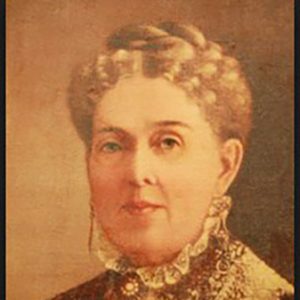calsfoundation@cals.org
Amanda Beardsley Trulock (1811–1891)
Amanda Beardsley Trulock was an antebellum woman from Connecticut who married a Georgia cotton planter, migrated to Arkansas, and eventually became a plantation proprietor and sole owner of sixty-two slaves near Pine Bluff (Jefferson County). She was one among the small number of American women from abolitionist New England who married into a slave-owning family before embracing the institution of slavery herself. However, largely due to her “Yankee” heritage and continued association with her New England family, Trulock was an atypical example of an antebellum slaveholder in the Delta. Her personal papers (primarily correspondence to her Connecticut family) represent an important documentation of plantation life, the Civil War, and emancipation in Arkansas history.
Born on April 22, 1811, to Nicholas and Polly Beardsley, Amanda Beardsley lived the first twenty-six years of her life in Bridgeport, Connecticut, before marrying a slave-owning cotton planter named James Trulock in 1837. They initially lived on his plantation in southwestern Georgia but eventually migrated to the Arkansas River area in 1845. They settled on a plantation homestead about eight miles east of Pine Bluff, which they named Prairie Place. Bringing numerous slaves with them, they cleared new cotton lands as Amanda Trulock oversaw all domestic activities and hosted a small boarding school for local planters’ daughters. By 1849, she had given birth to seven children, with one daughter and four sons still surviving at this time. When her husband died unexpectedly that same year, Trulock faced widowhood, debt, and the sole responsibility of slave ownership. Despite strong pressure from her family to sell all her assets and return to New England with her children, Trulock remained in Arkansas.
Trulock was an unconventional Arkansas woman of her era in at least three respects. First, she maintained remarkably close associations with her native region throughout the 1850s—precisely the time when polarizing sectionalism divided the nation between free and slave states. She spent every summer of that decade in Bridgeport, gradually leaving all her children there to attend school while she returned to Arkansas each autumn with a different female member of her extended family. The annual 2,800-mile round trip often took twenty to thirty days one way and was a highly unusual undertaking for that time.
Second, Trulock exhibited a unique perspective on human enslavement that defies easy categorization but was probably atypical for Delta planters. Originally unaccustomed to slavery, she became a staunch advocate of the institution upon marriage. However, as a widow, she apparently endowed an enslaved man named Reuben Blackwell with all authority to manage agricultural operations. Blackwell acted as a kind of co-manager of the plantation, and, although he was enslaved, he was so efficient that he incited envy from white planters in the region. Trulock also declined any opportunity to increase her slaveholdings through purchase on the slave market. Her rationale behind this unusual financial decision is unclear, but there is plausible evidence that she supported slave owning yet deplored slave trading as a greater moral offense.
Finally, Trulock was notably ambivalent in supporting either side during the Civil War. When the conflict began, she and her oldest son found themselves cut off from all of her children and Connecticut family for over two years. And although her son was of military age, Trulock purchased for him an exemption from Confederate military service, as he supervised their slaves until the arrival of the Union army in 1863. She discouraged her second son from returning to Arkansas in 1864 out of fear that he would be conscripted by either side; this son was compelled into Confederate service not long after he arrived in Arkansas and her oldest son had returned to the North.
Trulock endured the closing months of the war with a handful of former slaves. She returned to Connecticut in 1866 as her grown sons took over Prairie Place. She died in Bridgeport on April 20, 1891, apparently having never returned to Arkansas.
For additional information:
Edwards, Gary T. “Yankee Mistress of the Old South: Amanda Trulock, Slavery, and Northern Identity in the Arkansas Delta.” In Arkansas Women: Their Lives, Their Times, edited by Cherisse Jones-Branch and Gary T. Edwards. Athens: University of Georgia Press, 2018.
Greenberg, Brooke. “‘Ties That I Have to Bind Me Here’: Amanda Beardsley Trulock in the Arkansas Delta, 1845–1866.” Arkansas Historical Quarterly 77 (Spring 2018): 21–44.
Malloy, Sarah Brooke. “‘The health of our family’: The Correspondence of Amanda Beardsley Trulock, 1837–1868.” MA thesis, University of Arkansas, 2005.
Prestwood, Rebecca Norman. “Amanda Trulock: A Connecticut Yankee in Antebellum Arkansas.” MA thesis, University of Central Arkansas, 1996.
Trulock Family Papers. Special Collections. University of Arkansas Libraries, Fayetteville, Arkansas.
Gary T. Edwards
Arkansas State University
 Business, Commerce, and Industry
Business, Commerce, and Industry Louisiana Purchase through Early Statehood, 1803 through 1860
Louisiana Purchase through Early Statehood, 1803 through 1860 Amanda Beardsley Trulock
Amanda Beardsley Trulock 



Comments
No comments on this entry yet.